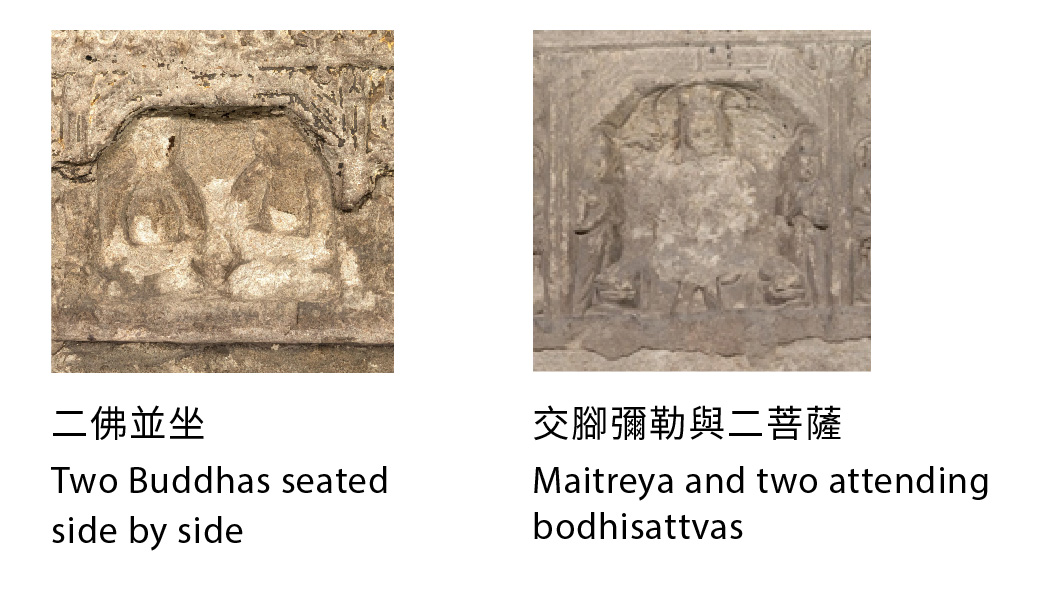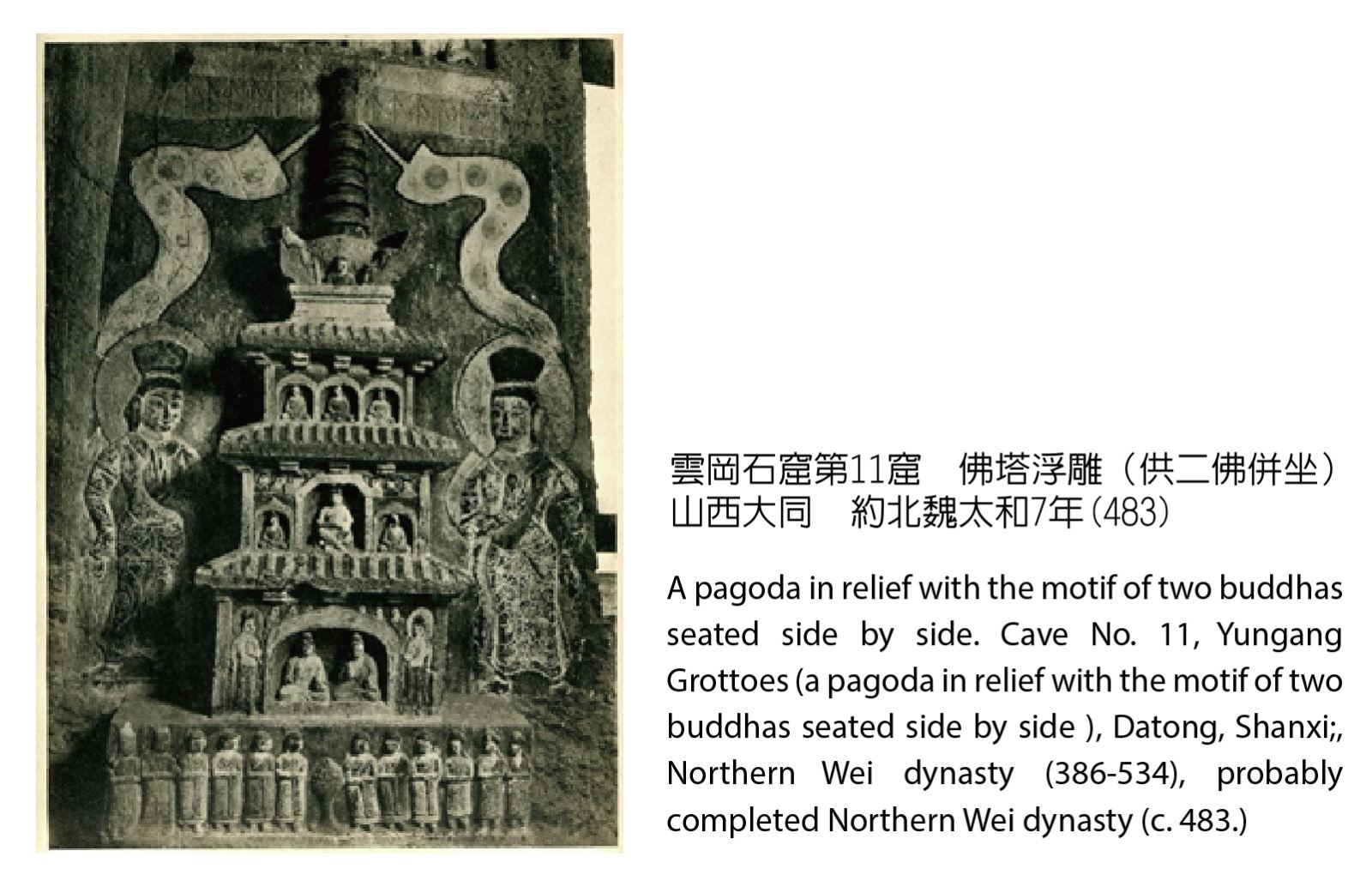依據塔座的造像銘文,此塔為北魏獻文帝天安元年(466)宮內小官曹天度所造,為現存中國閣樓式佛塔的最早遺存,並有明確紀年。因其在佛教史、藝術史方面的價值,民國100年(2011)經文化部公告指定為國寶。
According to the inscription at the bottom, this pagoda was dedicated by minor court official Cao Tian-du in 466, during the Northern Wei dynasty. It is the earliest extant pagoda in the style of a Chinese pavilion and is clearly dated. The pagoda was designated a national treasure by the Ministry of Culture in 2011 for its outstanding value in the history of Buddhism and art.
石塔構成 Composition
全塔以砂岩雕刻,原由四段累疊組成。由下而上,第一段為塔座;第二段為九層塔身的第一至第七層;第三段為塔身的第八、九層;第四段為最頂的塔剎(現存山西朔州市文物保管所,在此以示意展示)。若包含塔剎,全塔原高約200公分。
Carved entirely in sandstone, the nine-layer pagoda originally consisted of four sections: from bottom to top, the base, the first to the seventh stories, the eighth and ninth stories, and the steeple (now in the collection of the Shuozhou Cultural Relics Administrative Office in Shanxi Province, China. Here shown in illustration). The pagoda would be approximately 200 cm including the steeple.
雕刻主題 Themes
塔身 The pagoda
為仿木構閣樓式方形佛塔,共九層。第一層設計較繁複:四面中央皆開龕,正面雕多寶佛與釋迦牟尼佛、即所謂的「二佛並坐」,背面雕交腳彌勒與二脇侍菩薩,兩側各雕一佛二菩薩;四角另各有闕形方墩以強化支撐。中央佛龕以外的空間、與第二層以上四面,都均整佈滿禪坐千佛。根據統計,包含塔剎,全塔共雕1381 尊(塔身大尊佛菩薩11 尊、小禪坐佛1354尊;塔剎16 尊)。
This square pagoda is in the style of wooden Chinese pavilions and consists of nine stories. The first story has a more elaborate design and central niches on all four sides. The front has carvings of Prabhūtaratna and Sakyamuni seated side by side (the most important theme of the Lotus Sutra), the back has a cross-legged Maitreya and two attending bodhisattvas, and the two sides each have one buddha and two bodhisattvas.
The four corners of the first story are reinforced with tower-shaped square buttresses. The space surrounding the central niches on the first story and all four sides of the stories above the second are filled with meditating buddhas. Including the steeple, the pagoda has a total of 1,381 carved deities (11 great buddhas and bodhisattvas and 1,354 seated buddhas on the pagoda and16 deities on the steeple).

塔座 Base
亦為方形。正面分三欄,中央為香爐與二供養比丘,兩側為蹲踞吼獅與寶蓮;左右面分別為男女供養人,按身高大小面朝座前排列;背面主體為陰刻造像銘文,兩側男女供養人各一,乃與兩側供養人接續。
The base is square and has decorative carvings. The front is divided into three columns, the center one carved to represent an incense burner and two monks, and the two side columns carved with crouching lions and a lotus flower. The right and left sides of the base are carved with male and female worshippers arranged according to height. The back of the base is an engraved inscription flanked by a male and a female worshipper, who also form an extension of the arrangement of worshippers on the right and left sides of the base.
塔剎 Steeple
山西朔州市文物保管所藏
Now in the collection of the Shuozhou Cultural Relics Administrative Office in Shanxi Province,China
除下端榫頭外,分為佛座、覆缽、相輪三部分。佛座四面開龕,均雕二佛並坐,四角亦高浮雕坐佛。
The bottom is a tenon, while the upper part consists of the seat of the buddhas, an inverted bowl-shaped structure, and a finial. The seat of the buddhas has niches on all four sides, and the four corners are decorated with seated buddhas in high relief.
銘文解讀 Inscription
白話譯文
佛教的旨趣本是寧靜安寂,其弘揚需仰賴於人。聖教並不會主動運行,其推行有賴於相互的感通。因此,信奉佛教之人都會擔心自己能力太小,而以實際行動弘揚佛教,必有好的果報。於是我用全部家財造此石塔,將其裝飾得光鮮亮麗,以求解除心中長年的掛慮,並祝福當今皇上壽與天地並長,德業興隆,運化四方,皇太后與皇太子永享福祚,諸同僚、內小臣、已故以及健在的宗親們都能遠離塗炭,成人、嬰兒都能得到覺悟的果報。天安元年歲次丙午五月五日,宮內小臣曹天度為亡父穎寧、亡子玄明造於平城(今山西大同)。
註:天安元年(466)為北魏獻文帝拓拔弘(465-471在位)的年號,故銘文的「弘」字避諱作「弓口」。皇太后為其嫡母、文成帝之后馮氏(馮太后,441-490);皇太子為其子、即後來推行漢化、著名的北魏孝文帝拓拔宏(471-499在位)。
According to the inscription, this pagoda was dedicated by Cao Tian-du, a minor court official, to his late father and son in 466, during the Northern Wei dynasty. In addition to praying for his own relief from worries, Cao also wished the longevity and blessings of the Emperor Xianwen (r. 465-471), the Empress Dowager Feng (441-490), and the crown prince (future Emperor Xiaowen,r. 471–499), as well as prayed for his family and friends can divorce from disasters and sufferings while receiving enlightenment.
國寶指定 Significance
佛塔在印度最初為供奉釋迦牟尼佛舍利而起建,為寺廟的中心,以有巨大的覆缽為特徵,其上有傘蓋。隨著佛教經中亞傳入中國,佛塔逐漸向上發展,最終與中國閣樓建築相結合。
此件石塔為現存中國閣樓式佛塔的最早遺存,仿木構雕刻對理解中國北朝建築有相當價值。其二佛併坐、千佛等主題透露出與《法華》信仰有關,可謂開啟雲岡中期(約465-493)相同主題造像之先河。
The pagoda was the first building in India to be used to store the śarīra (the remains) of akyamuni. It is placed at the center of a monastery and typically has an inverted bowl-shaped structure and a canopy on top. As Buddhism spread to China through central Asia, the pagoda became progressively taller and eventually incorporated the architectural style of the Chinese pavilion.
This stone pagoda is the earliest extant specimen of a Chinese pavilion-style pagoda. Its imitation of carved wood sculpture gives great insight into Chinese architecture during the Northern dynasties. The theme of Prabhūtaratna and Sakyamuni seated side by side and the thousand buddhas reveal the connection with the Lotus Sutra. This paved the way for similar iconography seen in the middle period of the Yungang Grottoes (c. 465–493).

國寶背後的故事 Story behind the national treasure
此塔原置於山西朔州崇福寺的彌陀殿(金代1153年建成)。日本侵華期間攻陷山西,此塔被掠奪至日本東京帝室博物館(今東京國立博物館);二戰結束後連同其他戰爭掠奪文物歸還我國。民國44年(1955)國立歷史博物館肇建,45年(1956)此塔由教育部撥交該館典藏。民國100年(2011)此塔經文化部公告指定為國寶。
當日軍準備將此塔運往日本時,一位朔州市民將塔剎藏起,塔剎因此沒被運走,今收藏於山西朔州市文物保管所。
This pagoda was originally housed in the Maitreya Hall (Jin dynasty, completed in 1153) of Chongfu Monastery in Shuozhou, in China’s Shanxi Province. During the Japanese invasion of China, the pagoda was taken to the Tokyo Imperial Museum (now the Tokyo National Museum). The steeple had been hidden away by a Shuozhou resident as the Japanese prepared to ship the pagoda to Japan, so the steeple never left China and is now in the collection of the Shuozhou Cultural Relics Administrative Office in Shanxi Province. Following the end of the Second World War, the pagoda was returned to the Republic of China in Taiwan together with other looted cultural relics. In 1955, the National Museum of History was established and was entrusted with the pagoda by the Ministry of Education. The pagoda was designated a national treasure by the Ministry of Culture in 2011 for its outstanding value in the history of Buddhism and art.
緣起 Background to the exhibition
國立歷史博物館於民國107年(2018)七月起進行閉館整建工程,全數文物移出台北市南海路館址,部分館藏移存國立故宮博物院南部院區庫房。藉此文物南移的機會,兩館合作推出此國寶級文物特展。
The National Museum of History has been closed since July 2018 for major renovations. The museum’s collections were moved out of its Taipei facilities, and some are now in the safekeeping of the Southern Branch of the National Palace Museum. This was a rare opportunity for the two museums to work together to present this national treasure to the public in southern Taiwan.